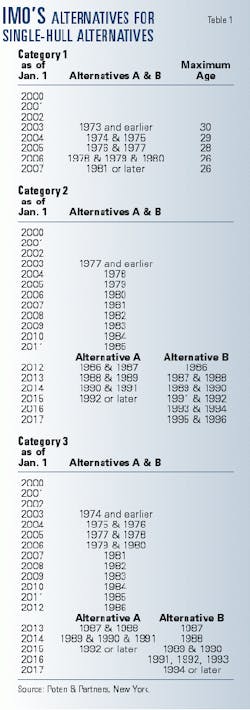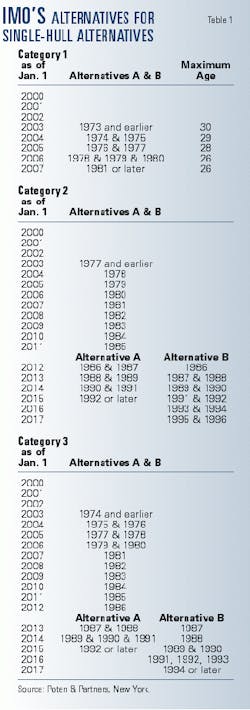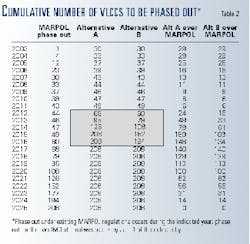Demise of single-hull, ocean-going oil tankers moved much closer last month when the UN's International Maritime Organization (IMO) took its "first, formal step" towards a global timetable for accelerated phase-out of the vessels.
The 45th session of IMO's Marine Environment Protection Committee (MEPC 45) approved a set of proposed amendments to MARPOL 73/78. That is the International Convention for the Prevention of Pollution from Ships (1973), amended by a subsequent Protocol in 1978.
MARPOL 73/78 has its own phase-out schedule that has come under pressure to be accelerated since the Erika, a Maltese-registered tanker, broke in half in an Atlantic storm Dec. 12, 1999, about 100 km off the northwestern coast of France, The vessel spilled 10,000-18,000 tonnes of heavy fuel oil (OGJ, Dec. 20, 1999, p. 38).
IMO said that approval of the proposed amendments by MEPC 45 paves the way for adoption of a revised Regulation 13G of MARPOL at MEPC 46. That meeting is set for April 2001, a timing IMO says was "brought forward ellipse to accommodate the swiftest possible introduction of new rules."
Major shipping consultant Poten & Partners, New York, looked at the proposals, compared the timetables of MEPC 45's Alternatives A and B, and assessed their impact on very large crude carriers (VLCCs), the industry workhorse tanker classification consisting of vessels 200,000 dwt or larger.
As of Mar. 1, 2000, Clarkson Research Studies said the total ultra large (UL) and VLCC tanker fleet capacity stood at 122.4 million dwt and made up 43% of the total oil tanker fleet of more than 10,000-dwt vessels.
Categories; alternatives
In its draft revision of MARPOL Regulation 13G, the MEPC working group identified three categories of oil tankers:
- Category 1 includes oil tankers of 20,000 dwt and larger that carry crude oil, fuel oil, heavy diesel oil, or lubricating oil and tankers of 30,000 dwt or larger that carry other oils, neither group of which complying with the requirements for protectively located segregated ballast tanks (SBTs), commonly known as "pre-MARPOL" tankers.
- Category 2 includes the same size designations of capacities but refers to those that do comply with the SBT requirements ("MARPOL" tankers).
- Category 3 includes oil tankers of 5,000 dwt or larger but less than the tonnage specified for Categories 1 and 2 tankers.
The draft revision sets out two alternative schemes for phasing-out single-hull tankers.
Both schemes would see Category 1 vessels phased-out progressively between Jan. 1, 2003, and Jan. 1, 2007, depending on their year of delivery.
Both schemes would also phase out Category 2 tankers built in 1986 or earlier after their 25th year of operation. But Category 2 ships built after 1986 would be phased out between 2012 and 2015 under Alternative A and between 2012 and 2017 under Alternative B.
For Category 3 tankers, both schemes involve progressive phasing out between 2003 and 2013 tankers built in or before 1987. But ships built after 1987 would be phased out between 2013 and 2015 for ships under Alternative A and between 2013 and 2017 under Alternative B.
IMO said the working group also agreed that continued operation of Category 2 oil tankers beyond 2010 should be permitted only for "high quality ships" that had been subject to a Condition Assessment Scheme (CAS).
An informal group prepared a preliminary set of underlying principles to be addressed in considering the scheme that fall into three sections:
- Checks on the physical condition of the vessel.
- Checks on documentation recording a vessel's past performance.
- Possible improvements in survey and inspection practice.
This group stressed, according to IMO, that the introduction of a CAS should not undermine the Enhanced Survey Program (ESP) system and that the scheme would assume that vessels should pass their ESPs.
Timetables
Poten & Partners was quick to analyze these proposals and to publicize what it says will be "a significant impact on the future supply of tanker capacity, and hence on shipping rates and shipbuilding prospects."
Table 1 presents Poten & Partners' phase-out schedules for each category. The consultant points out that the maximum age phase-out schedule for Category 2 is the same through 2011 when the maximum age for service for all tankers is 26 years.
Alternatives A and B have different schedules beginning in 2012 with Alternative A having the more accelerated one.
And it adds that the IMO plan avoids the more drastic phase-out schedules initially proposed after the Erika incident. One such proposal phased out all singe-hull vessels by 2010.
Nevertheless, says Poten & Partners, the essential "drop dead" age of 25 years will "have an impact on tanker supply as the option of trading vessels until they are 30 years old will be eliminated.
"The compromise IMO phase out proposals are just that-proposals. [While the compromise] has general European support, this is not to say that all the maritime nations are as yet prepared to vote in favor of any compromises," says the consultant.
"Negotiations will be carried on in an atmosphere of shipyards operating near capacity for most tanker classes, strong oil demand, and with rates at record levels."
VLCC impact
Existing MARPOL regulations phase out non-SBT vessels after 25 years, explains Poten & Partners, unless they operate with hydrostatic balanced loading (HBL), which extends their lives to 30 years. HBL involves the loading of a cargo so that its surface remains below the waterline of the tanker (OGJ, May 22, 2000, p. 65).
If the tanker ruptures its bottom and does not list, the seawater pressure at the bottom of the tank is greater than the pressure exerted by the oil cargo, which prevents oil from leaking from the tanker.
The current IMO proposals, therefore, represent no significant change in VLCC supply, "assuming continued oil company reluctance to use HBL on a widespread basis."
The impact on Category 2, however, and for VLCCs in particular is much different.
As stated, Category 2 represents single-hull crude carriers greater than 20,000 dwt and product carriers greater than 30,000 dwt built between 1982 and 1995. Category 1 vessels built before 1982 do not have SBT.
By default, therefore, vessels built before 1982 included in Category 2 must be pre-MARPOL tankers with SBT. These have 30-year lives under existing MARPOL regulations.
Table 2 shows that the major differences between the proposals for VLCCs occur in 2012-2016 when Alternative A significantly outpaces Alternative B's phase-out schedule. The table is based on the current VLCC fleet profile.
Poten & Partners says that the original MARPOL regulations gave the shipping industry 20 years to adjust to its phase out schedule. The two IMO alternatives accelerate phase out with ramifications that are "significant in 2003 and draconian in 2015," as is highlighted in Table 2.
Fig. 1 illustrates the cumulative number of VLCCs to be phased out for the existing and proposed IMO schedules.
Such an accelerated phase out, says the consultant, will help to ensure "perpetual prosperity to shipyards and owners of double hull tankers at the expense of owners of single hull tankers."





